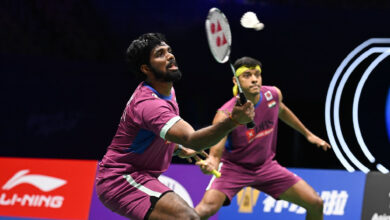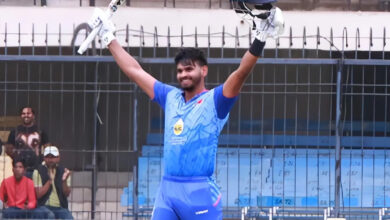Geography on its side, but Guwahati’s Badminton academy has uphill climb matching Hyderabad’s hory | Badminton News

Ashmita Chaliha led 10-5 in the opening set against upcoming Thai youngster Lalinrat Chaiwan, 22, and promptly ceded advantage to go a set down at her home event, the Guwahati Masters Super 100. Next set, the 24-year-old Indian led for most part, including at 15-11 to give herself a 18-16 platform from where she could’ve forced a decider. But her challenge fizzled out as she lost 21-17, 22-20 in 38 minutes.The powerful southpaw from Assam has the game, and the attack that ought to have made her a straight successor to PV Sindhu. But though she impresses every time she steps onto the court, the breakthrough is taking a long while, as yet another season draws to a close. Ashmita continues searching for a way to close out matches.
While Assam’s Dipankar Bhattacharjee brought the jump smash to Indian shores, Ashmita isn’t the first woman from the state to impress with her leaping kill shot. One of the biggest – and last – hammerings handed out to Saina Nehwal in her junior days in early 2000s, came from Assam’s most audacious and well built shuttlers, Krishna Dekaraja. Nehwal was bagelled in fact. Experienced and trained eyes on the circuit say, Krishna could jump-smash higher than 6 footer male shuttlers at Bangalore. She was poised for a breakout, but the seniors career didn’t take off as the crucial 17-20 years stage petered off, and then an ACL knee injury felled her efforts. Saina meanwhile was guided excellently the brightest coaching brain from the country, Pullela Gopichand, and bounced back spectacularly from that whitewash, and carved for herself a very successful international career.
The stream of talent from Assam continues with youngster Isharani Baruah from Dibrugarh whipping up one fine storm on courts, and showing pugnacious intent to challenge the bigger names in juniors.
The North East has seen the emergence of Meiraba Maisnam in singles, though consency eludes him compulsively. And while there is much excitement about the men’s doubles pair, Manjit Singh Khwairakpam and Dingku Singh Konthoujam, also from Manipur, fingers are anxiously crossed about their temperament to finish games as well. Dingku also plays mixed with Priya Konjengbam.
For a set of shuttlers gifted physically with strength and stamina, and no dearth of flair, results that see frittering of leads and running out of steam, are recurring occasions to wonder why badminton isn’t taking off and scaling higher realms in that part of the country.
Isharani Baruah in action on Day 1 of the Guwahati Masters (BAI)
A swanky new academy of the Badminton Association of India with top-notch facilities has come up at Guwahati in the last year. It promises personalised attention, and has plentiful coaches to help those who show the hunger to succeed. Some seriously big names in coaching were announced and should be at hand, once there’s a glimmer of grit shown. The base fitness standards are expected to go up, and fundamentals drilled in. Results will be keenly followed in the next 2-3 years as a bunch of teenagers are assembled there. While it is open to juniors from across the country, it is especially helpful for talent from the north east.
Travelling back to the hills in Mizoram and Manipur is an overnight journey away now, while training in Chandigarh, Bangalore and Mumbai would typically take two days train. Parents from northeast can drop in, in case of homesickness with dances not more than 500-600 kms.
While the north east is hardly homogenous, and recently troubled faultlines throw ethnic tensions and differences into stark relief, proximity to home is a major factor for upcoming shuttlers headed to Guwahati. Experiments to transplant them to Bangalore have been going on for 20 odd years now, but both of India’s premier centres with the coaching expertise and tactical nous, will need to factor in the cultural strangeness of Bangalore and Hyderabad to north easterners and the adjustments demanded off them.
Leaving the comfort zones has proven almighty difficult, and there are further complexities of dealing with teenagers who upon finding freedom in the big city, are horically lost to dractions. There’s a case from a decade ago, of a gifted player from the north east, struggling to wean himself away from video games once in Bangalore, and wasting away some serious talent. It wasn’t even about frequenting arcades, but going to sleep late and turning up groggy for practice the next morning. The onus of making the most of a training stint after travelling so far away from home, falls on teenage minds, as there’s only so much that coaches will push. Disciplining teens who are living miles away from families is a delicate tightrope.
The language poses a problem. And for sturdy individuals used to their fork fill of bamboo-shoot, beef and pork, and a different rice even, the southern metro mess kitchens with just the chicken and lamb and hugely different spicing, can all prove to be way much too different. Levelling up in a sport itself is a high pressure phase for juniors, having to bite into unfamiliar fare thrice a day has seen a few drop it all and head back home.
Guwahati offers a convenient alternative. But it will need to prove it can produce players, who can transition to the international circuit and get results, the sorts that Indian badminton is accustomed to, as delivered consently in Hyderabad. Ashmita who has steadfastly insed on building herself a career while not leaving home in Guwahati, will be the starting point of the litmus test. While motivation varies from individual to individual, shuttlers from the north east need that one example from amongst them to follow, who shows fiery ambition and puts in the very hard yards of effort that’s needed to excel in this sport.
Hmar Lalthazuala, currently lodged at Guwahati, was scouted out Pullela Gopichand for not just his height, but also ace talent, a start point of ambition and long limbs. He would hone the youngster’s attitude, guide him through the growth spurt and get him started on winning even in Hyderabad, before he made the move back to Guwahati. How to travel to tournaments, what are match-day routines, how to strategise and how to close out matches are specific skills that need to be hammered in, and are quite different from mere training and fitness work.
Gopichand mastered this drill from scratch for two Olympic and five World Championship medalling athletes, and produced results consently in elite levels. The Padukone academy has found its own success, though not as prolific as what Hyderabad produced. Still, the two centres boast of the best results for India internationally, and have laid down the marker for Guwahati to follow.
Mizoram, where Gopichand extensively scouted and helped put in place a basic framework to serve as a feeder centre, posed its unique charming challenges. They love their art and music out there, nurse deep community ties, have clean air, healthy food and a cushy family cocoon with faith and culture being important to their upbringing. Education is important to the Mizo community, and it needed psychological counselling to convince them to leave the idyllic hills in pursuit of cut-throat competition.
Community-owned land was pledged for a high altitude station, a bunch of centres came up, 4 courts took shape, coaches were trained and youngsters spent a month in Hyderabad. A self-sustaining model with 41 percent expenses of shuttles, shoes, equipment borne the community has kicked off. At some point, sports science and physios will need to step up, if fledgling careers are to be shaped. Physiques and enthusiasm vibed too, and badminton took root. Lalthazuala, the brightest of the lot, even won a Youth meet in Lucknow.
Still all this is only the start of any elite career. A fraction of the journey. Smart training, injury prevention, recovery methods and tournament planning all need to kick in. A heavily coached game on-court, badminton still has only one Gopichand and one Vimal Kumar amongst Indians who have delivered elite results. The North East teems with the right body-type for the sport, and has a state-of-the-art academy to boot now. But it is always the human coaching brain that shapes elite careers.
Guwahati offers a comfort zone physically to shuttlers from neighbouring states, but peak performance needs players to step out of the comforting cocoons of their minds. And they should be prepared for the physical effort to be plainly uncomfortable. Ashmita Chaliha will need to shift gears soon if she is to do justice to that wonderful southpaw game of hers. The whole of India, but specifically the North East, is waiting with bated breath.







